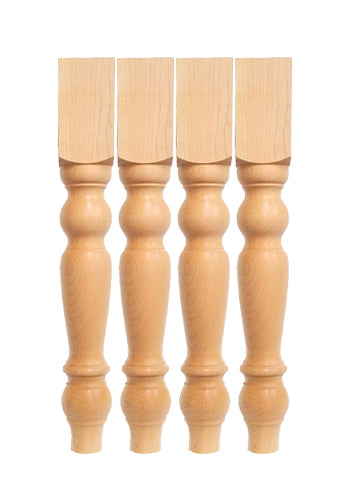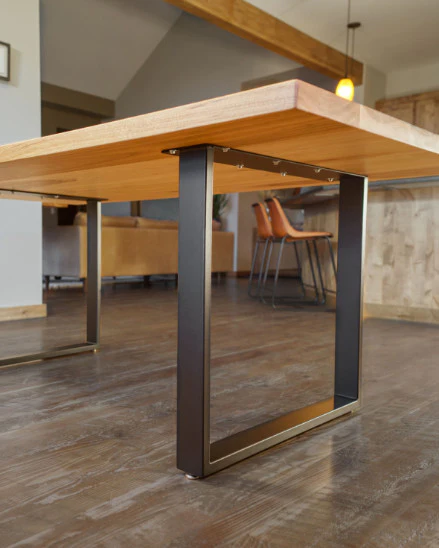Key Factors to Maintain in Mind for Table Legs Wood Choices
When picking timber for eating table legs, a number of essential aspects require cautious factor to consider to make certain both functionality and visual allure. The option of wood kind, characterized by its toughness and special grain patterns, plays a critical function in the general layout and durability of the piece.
Wood Types and Qualities
When choosing timber for dining table legs, it is important to understand the unique features of numerous wood kinds. Different woods provide distinctive benefits and negative aspects, affecting both the durability and aesthetic allure of the ended up item.
Oak, known for its remarkable durability, also features a prominent grain that can include personality to the table. Cherry wood, with its abundant shade that grows over time, offers an elegant look but might need more upkeep to protect against scrapes.
On the various other hand, softwoods like ache and fir are much more affordable and much easier to function with, yet they are less long lasting than hardwoods. Pine is light-weight and includes a warm, rustic look, making it a favored selection for laid-back dining settings. It is a lot more susceptible to scratches and dents.
Comprehending these qualities will assist in making a notified choice to guarantee the legs of the dining table meet both practical and visual demands.
Grain Patterns and Appearance
The timber's grain is not merely an aesthetic characteristic; it imparts a distinct personality and beauty to each piece. Various timber species show unique grain patterns, ranging from the straight lines of maple to the intricate swirls of oak and the striking number of walnut.
In addition, the alignment and range of the grain can influence the regarded dimension and sophistication of the table. For example, larger, more noticable grains might provide a strong, remarkable impact, while finer, subtler grains can create an improved, downplayed look. Furthermore, the finishing procedure can additionally boost these patterns, stressing the natural charm of the wood and highlighting abundant hues.
Ultimately, the option of grain pattern must balance with other design aspects, such as the tabletop and bordering furniture, guaranteeing a natural aesthetic that boosts the eating experience. Thoughtful option of timber grain not only adds to the table's elegance however additionally mirrors the owner's preference and style.
Durability and Toughness
The longevity and toughness of eating table legs are critical considerations for making certain durability and security in any kind of eating room. Selecting the ideal timber is essential, as various species display differing levels of strength.

Inevitably, buying high-grade wood and durable building approaches will certainly generate an eating table that stands the examination of time, while supplying a dependable foundation for numerous dishes shared amongst friends and family. Focusing on longevity and stamina guarantees that your table stays useful and visually pleasing for several years to find.
Upkeep and Treatment
Correct maintenance and care are important for preserving the durability and toughness of dining table legs made from wood. Routine cleansing is essential; utilizing a soft, wet cloth makes sure that dust and debris do not collect, which can result in scrapes and monotony. It is a good idea to prevent extreme chemicals or abrasive products that could harm the surface.
Furthermore, using a suitable wood polish or wax periodically can assist maintain the sheen and shield the timber from wetness and spills. Nonetheless, it is go right here crucial to comply with the supplier's suggestions pertaining to the sort of product to utilize, as particular coatings might respond detrimentally to certain chemicals.
Humidity and temperature variations can additionally impact wood table legs, causing them to warp or click to find out more crack. It's best to put the table away from straight sunshine and warm sources. If the table legs have any scratches or damages, addressing these immediately can avoid more damages.
Lastly, occasionally inspecting the joints and screws for rigidity is necessary to maintain architectural stability (Dining Table Legs Wood). By sticking to these upkeep practices, property owners can ensure their wooden eating table legs continue to be enticing and practical for several years to come
Ecological Considerations
When choosing timber for eating table legs, it's important to take environmental factors to consider into account. The sourcing and sustainability of wood are extremely important in reducing ecological effect. Going with timber from qualified sources, such as those recommended by the Forest Stewardship Council (FSC), makes sure that the timber is collected responsibly, advertising woodland conservation and biodiversity.

Furthermore, regional sourcing of timber lowers transportation emissions, sustaining neighborhood economic situations while decreasing ecological influence. It is also recommended to be mindful of the wood's therapy and finishing processes, as certain chemicals can be hazardous to both human health and the environment. By focusing on lasting timber choices, customers can add to environmental preservation while taking pleasure in the sturdiness and beauty of their dining table legs.
Final Thought
In conclusion, selecting wood for eating table legs demands careful consideration of different variables, consisting of wood types, grain patterns, and sturdiness. The aesthetic charm of special grain patterns can enhance the total layout, while the stamina of hardwoods makes certain long life. Upkeep demands and get redirected here environmental sustainability further influence wood options, highlighting the value of sourcing from licensed or redeemed materials. An educated selection procedure ultimately contributes to a practical and aesthetically enticing dining space that straightens with sustainable techniques.
When picking timber for dining table legs, numerous crucial variables warrant careful consideration to guarantee both functionality and visual charm.Proper maintenance and care are vital for protecting the sturdiness and stamina of dining table legs made from wood.When picking wood for eating table legs, it's vital to take ecological considerations right into account. By focusing on lasting wood selections, customers can add to ecological conservation while enjoying the sturdiness and beauty of their dining table legs.
In conclusion, picking timber for eating table legs demands careful consideration of numerous aspects, including timber types, grain patterns, and toughness. Dining Table Legs Wood.